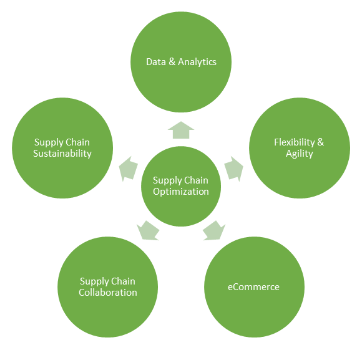Navigating the Future: Supply Chain Optimization Part 2

Welcome back to our series on Supply Chain Trends! In our previous post, we delved into the trends driving supply chain optimization in the pillars of Data & Analytics, and Flexibility & Agility. In this follow-up installment, we will explore the trends shaping the future of eCommerce, Supply Chain Collaboration, and Sustainability. These areas are not only crucial for meeting current consumer demands, but also for building resilient and future-proof supply chains.

eCommerce: Transforming Supply Chain Dynamics
The impact of eCommerce on the future of supply chains cannot be overstated. With over 2 billion consumers purchasing goods digitally, eCommerce has revolutionized supply chains, introducing both opportunities and challenges.
On one hand, it enhances efficiency through real-time communication between buyers and sellers, and simplifies record management processes. On the other, it poses challenges such as increased packaging waste, inefficient last-mile delivery, and the need for meticulous inventory management due to fluctuating demand. While eCommerce brings much-needed convenience, it also necessitates innovative solutions to mitigate its impact on supply chain sustainability.
Supply Chain Collaboration: Enhancing Efficiency Through Partnership
Organizations are increasingly pursuing Supply Chain Collaboration initiatives to optimize their operations. Supply Chain Collaboration involves two or more independent firms working together to plan and execute supply chain activities; sharing resources, information, rewards, and responsibilities, and jointly solving problems. This collaboration is crucial for improving agility, reducing the bullwhip effect (inventory fluctuations due to changes in customer demand), and orchestrating supply chains more effectively.
The benefits include significant reductions in inventories and costs, improved speed, service levels, and customer satisfaction. Supply Chain Collaboration is an essential component of effective supply chain management and business resilience.
Sustainability: Building a Greener Future
Sustainable supply chains integrate environmentally, socially, and financially viable practices throughout the product lifecycle, from design to disposal. These practices respond to pressures for better environmental stewardship and social responsibility. They aim to reduce environmental impact, improve social equity, and enhance economic efficiency, addressing global challenges like climate change and human rights.
Adopting sustainable supply chain practices can result in lower operating costs, a stronger brand, and improved business resilience, benefiting the environment, society, and economic health. Here are some key trends in supply chain sustainability:
- Circular Supply Chains:
Prioritizing the reuse and recycling of materials to maximize resource utilization and minimize waste. This model reduces greenhouse gas emissions, lowers environmental impact, and enhances resilience by reducing dependency on raw materials. However, proving the economic benefits to encourage widespread adoption remains a challenge.
- Environmentally Friendly Packaging:
Also known as Eco-Friendly or Sustainable Packaging, this focuses on recyclability, safety, and the use of recycled materials. It aims to minimize energy use and the depletion of natural resources, offering benefits such as reduced waste and carbon footprints, biodegradability, and the avoidance of toxic materials. Additionally, its lightweight nature may reduce shipping costs.
- Reverse Logistics:
Managing the return of products from consumers or retailers back to manufacturers, including activities like returns management, refurbishment, recycling, and disposal. Efficient reverse logistics allows companies to recapture value from returned products, reduce waste, and improve customer satisfaction, leading to lower operational costs and increased customer loyalty.
- Supply Chain Routing Optimization:
Planning and executing the most efficient and eco-friendly delivery routes. This helps companies reduce their carbon footprint, lower transportation costs, and improve delivery efficiency, contributing to sustainability goals such as reducing greenhouse gas emissions and energy consumption.
- Electric Vehicles (EVs):
A key component of sustainable supply chains, EVs represent a shift away from fossil fuel-dependent transportation. This transition significantly reduces greenhouse gas emissions, leading to benefits such as lower operating costs, improved corporate sustainability profiles, and potential regulatory advantages. The use of EVs in logistics, particularly in last-mile delivery, enhances operational efficiency and customer satisfaction due to their lower noise levels and zero tailpipe emissions.
Optimization Questions for Your Organization
As your organization considers optimizing its supply chain, it is valuable to reflect on the following questions:
- What is the current state of our supply chain? Assess key performance indicators (KPIs) such as order accuracy, order cycle time, and inventory turnover rate to understand strengths and weaknesses.
- What is the future state design of our supply chain, and will implementing these optimization capabilities help us achieve our goals?
- What are the long-term goals of our sustainability strategy, and how well do we currently meet them? What gaps exist, and what will it take to address them?
- What are the risks associated with pursuing a sustainability strategy? How could changes to the supply chain impact operational performance?
- Do we have the right technology in place? Evaluate whether your current technology stack meets your needs and consider investing in new solutions as necessary.
- What is our plan for continuous improvement? Supply chain optimization is an ongoing process, requiring regular review and continuous improvement.
- Do we have the resources and capital to implement new capabilities?
- What level of training and education will be required to implement optimization strategies?
Conclusion
Throughout this series, we have explored various trends impacting supply chains. Understanding and implementing these trends can profoundly affect your organization. Without proper preparation, the changes can result in prohibitive effects, negating the benefits of new tools and processes. In our next post, we will discuss the organizational changes needed to successfully implement the trends covered in this series.
Stay tuned, and don’t wait—start optimizing your supply chain. Contact us to learn more and get started on your journey to supply chain excellence.
PAST ARTICLES IN OUR SUPPLY CHAIN SERIES
– Navigating the Future: 9 Ways Tech and AI are Impacting Supply Chains
– Navigating the Future: How Automation is Shaping Supply Chains
